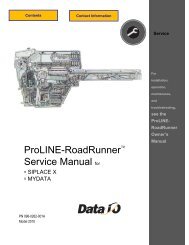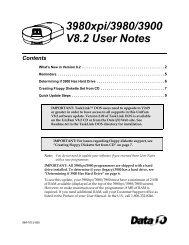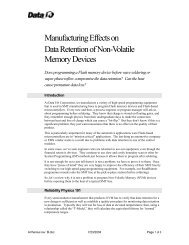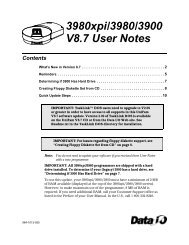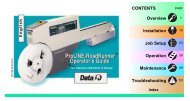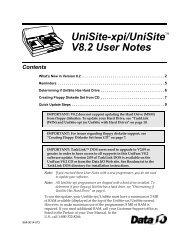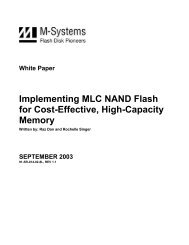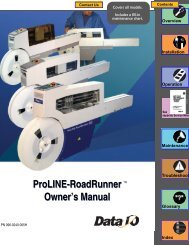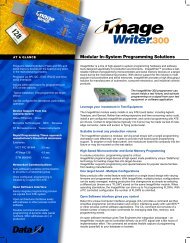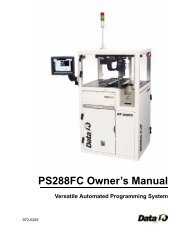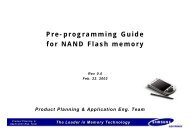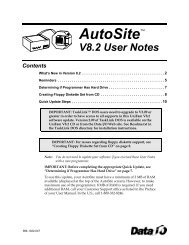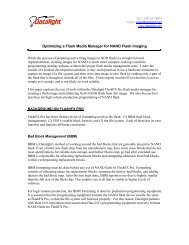3980xpi Users Manual - Data I/O Corporation
3980xpi Users Manual - Data I/O Corporation
3980xpi Users Manual - Data I/O Corporation
You also want an ePaper? Increase the reach of your titles
YUMPU automatically turns print PDFs into web optimized ePapers that Google loves.
Purge File<br />
Rename File<br />
Commands<br />
The parameters are described below:<br />
� Filename<br />
Specifies the name of the disk file to save RAM data to. This may be a new<br />
or existing filename you want to overwrite. If you are writing to an existing<br />
file, the current data in the file is replaced by the new data. The filename<br />
must follow standard DOS conventions (such as 27c256.dat or 16l8.dat).<br />
� Memory Begin Address (for memory devices only)<br />
Specifies the first address in RAM where data is to be saved. The default<br />
address is 0.<br />
� User <strong>Data</strong> Size<br />
Specifies the size, in hex bytes, of the data block to save. This value is<br />
normally equal to the device size. This option appears only if you have<br />
selected a memory device.<br />
More Commands/File Operations/Purge File<br />
This command deletes a file, or group of files, from a disk. To purge a file from<br />
a disk, follow these steps:<br />
1. Insert the disk with the file you want to delete into the disk drive.<br />
2. When you select the Purge File command, the dialog window fills with a<br />
directory listing. The programmer displays up to 28 files at one time. If<br />
there are more than 28 files, press CTRL+N to display the next page of<br />
files. Press CTRL+P to display the first page of files.<br />
If you do not see the file you want to delete, press F2, insert another disk,<br />
and return to the beginning of this step.<br />
3. Move the cursor to the Filename field and enter the name of the file you<br />
want to delete.<br />
Note: You can use an asterisk (*) as a wildcard. For example, to purge<br />
both 27512.dat and 27128.dat, you could type 27*.dat.<br />
4. Move the cursor to the Are you sure? field and press Y.<br />
CAUTION: If you do not want to delete the file, do not press Enter.<br />
5. To delete the file, press ENTER. If you do not want to delete the file, press F2<br />
to return to the File Operations menu.<br />
More Commands/File Operations/Rename File<br />
This command changes the name of a file. To rename a file, follow these steps:<br />
1. Insert the disk with the file you want to rename into the disk drive.<br />
2. When you select the Rename File command, the dialog window fills with<br />
the directory listing, displaying up to 28 files at a time. If there are more<br />
than 28 files, press CTRL+N to display the next page of files. Press<br />
CTRL+P to display the first page of files.<br />
If you do not see the file you want to rename, press F2, insert another<br />
disk, and return to the beginning of this step.<br />
<strong>3980xpi</strong>/3980/3900/2900 User <strong>Manual</strong> 4-55




